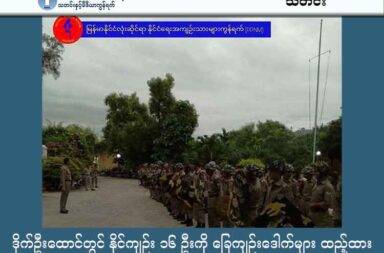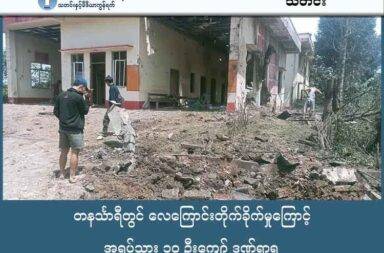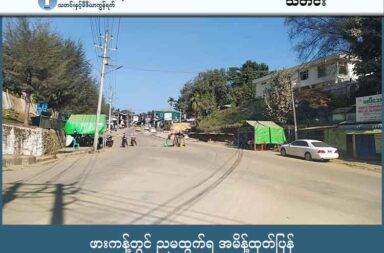Ethnic Ta’ang IDPs Struggle to Find Long-Term Places of Refuge
After more than seven years on a plot of land in Namkham, hundreds of displaced Ta’ang say they will soon need to find a new place to stay.
By NETWORK MEDIA GROUP (NMG)
Wednesday, March 27, 2019
Displaced Ta’ang in northern Shan State report that they are experiencing difficulties in securing places where they can stay after fleeing their homes due to armed conflict.
Currently, there are more than 300 Ta’ang IDPs [internally displaced people] in the Nay Won Ni camp in Namkham Township. The camp was established on a plot of land owned by the Ta’ang Culture and Tradition Organization, but the IDPs say they will need to relocate this year and are in urgent need of a new location in which they can live.
“It’s a land issue,” Lway Win Win Swe, a camp committee member in Nay Won Ni camp, told NMG.
While she said that the Ta’ang Culture and Tradition Organization has not “pushed [them] to leave,” the IDPs feel “it is time to leave,” at least by 2020, which will mark eight years on the land. The plot is used for official events held by the Ta’ang community.
The IDPs in Nay Won Ni fled from upper and lower Mang Loi and Kyu Seng village in the Olan Pa village tract of Mansi Township in Kachin State in 2012 after clashes intensified between the Kachin Indendence Army and the Burma Army.
“The important thing for us is to leave this camp. Currently, we don’t have a place to relocate to,” one IDP, Mai Than Aung, told NMG. “For relocation, we also need funds. Will we be okay in a new place with new challenges? We are so worried about these things.”
Lway Win Win Swe said that it is not yet safe for the IDPs to return to their homes.
“We cannot go back to Kachin State because clashes often occur in our area. Our houses were damaged by shells in 2017. There are still many landmines everywhere. For us, it’s still impossible to go back home,” she explained.
The main provider of food assistance for the people of Nay Won Ni camp is the World Food Programme (WFP), with additional help from civil society organizations. Some IDPs also take on daily labor to support their families. Mai Than Aung told NMG that many IDPs are concerned about restarting their lives again in another camp, trying to find new work, and miss their independence.
“We were so happy in our village. We worked in our paddy fields. Here, I have to work as a daily wage laborer,” he said. “Sometimes I have to carry rice and sugar cane. As daily wage laborers, sometimes no employer calls us. Some people look down us because we are refugees. They discriminate against us when it comes to payments. I feel so upset. Even though WFP provides us with food, I want to go home.”
IDPs in Nay Won Ni have asked the local authorities to help them find a new place to live, but no solution has been identified yet, as no donors have offered to purchase land and as the IDPs themselves have no money to do so, Lway Win Win Swe said.
“We are waiting. Since 2017, we have asked the government to help us. We already reported our difficulties to respective government officials in a meeting in Lashio [in northern Shan State],” she explained.
When Nay Won Ni was established, there were more than 900 people living in the camp. Many people gradually left—to stay with relatives, to seek work—and today 377 people remain.
In addition to Nay Won Ni, Namkham Township also hosts the Panglong camp and Jor 1 and 2 camps. The former is run by the Kachin Baptist Convention, and the latter two are run by the Catholic Church. There are more than 1,000 IDPs on these sites.


